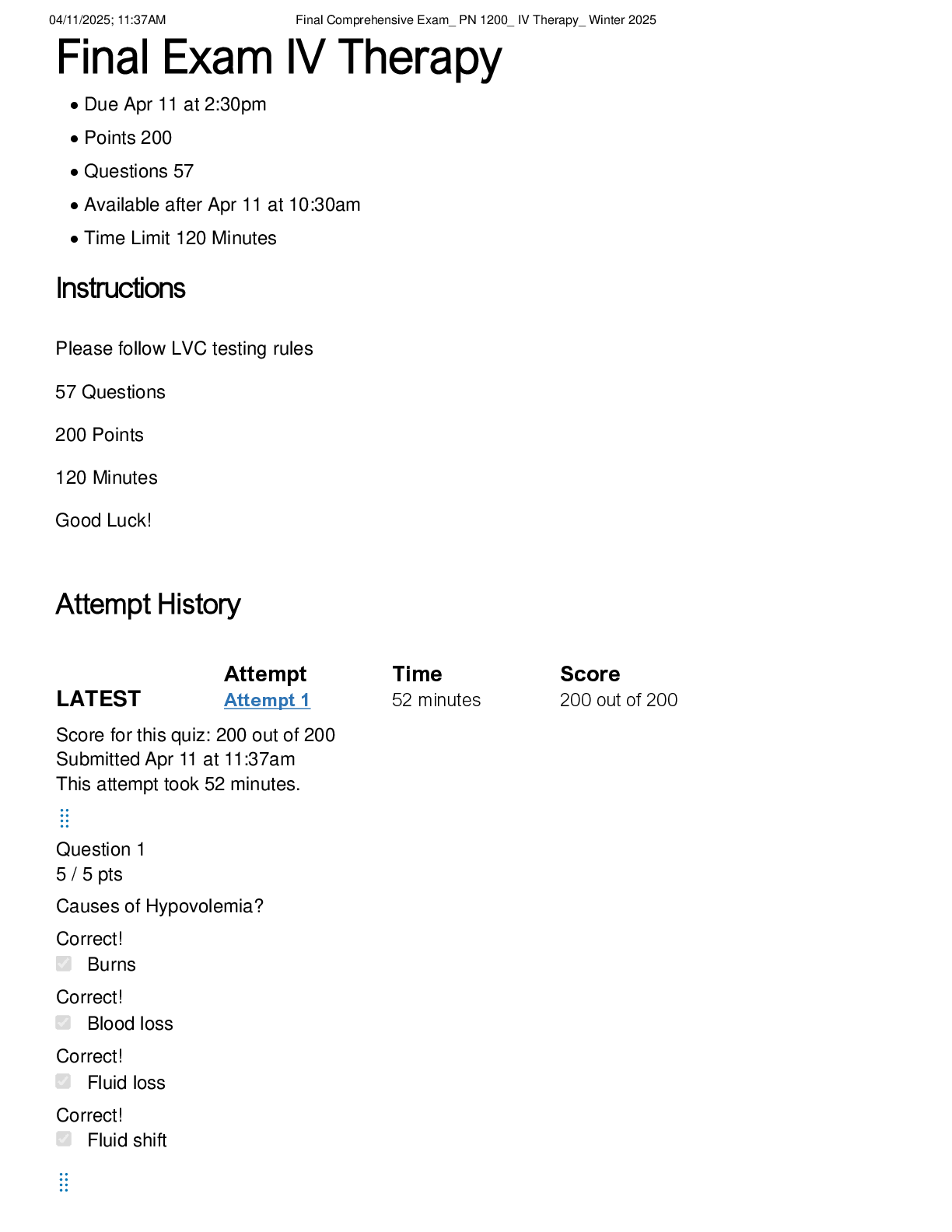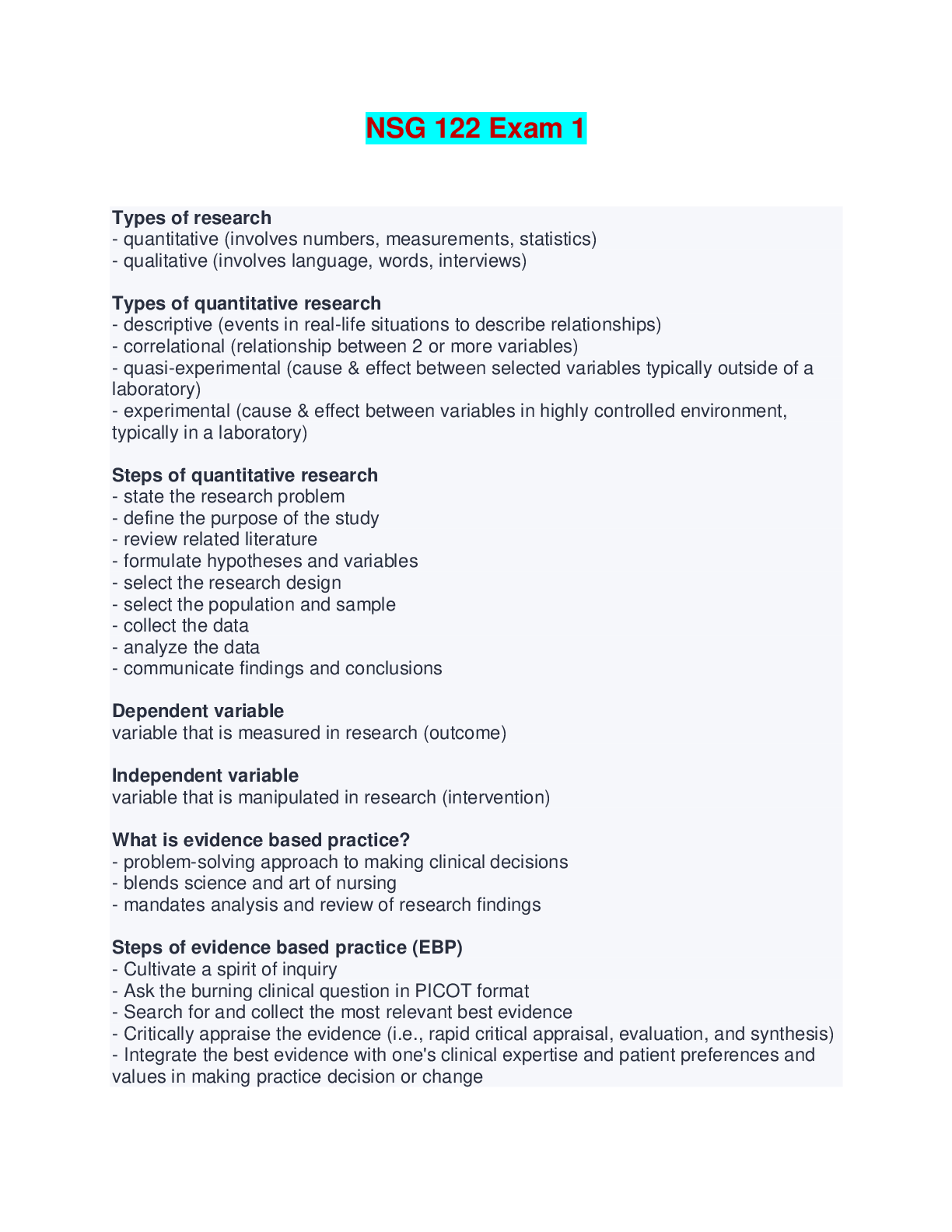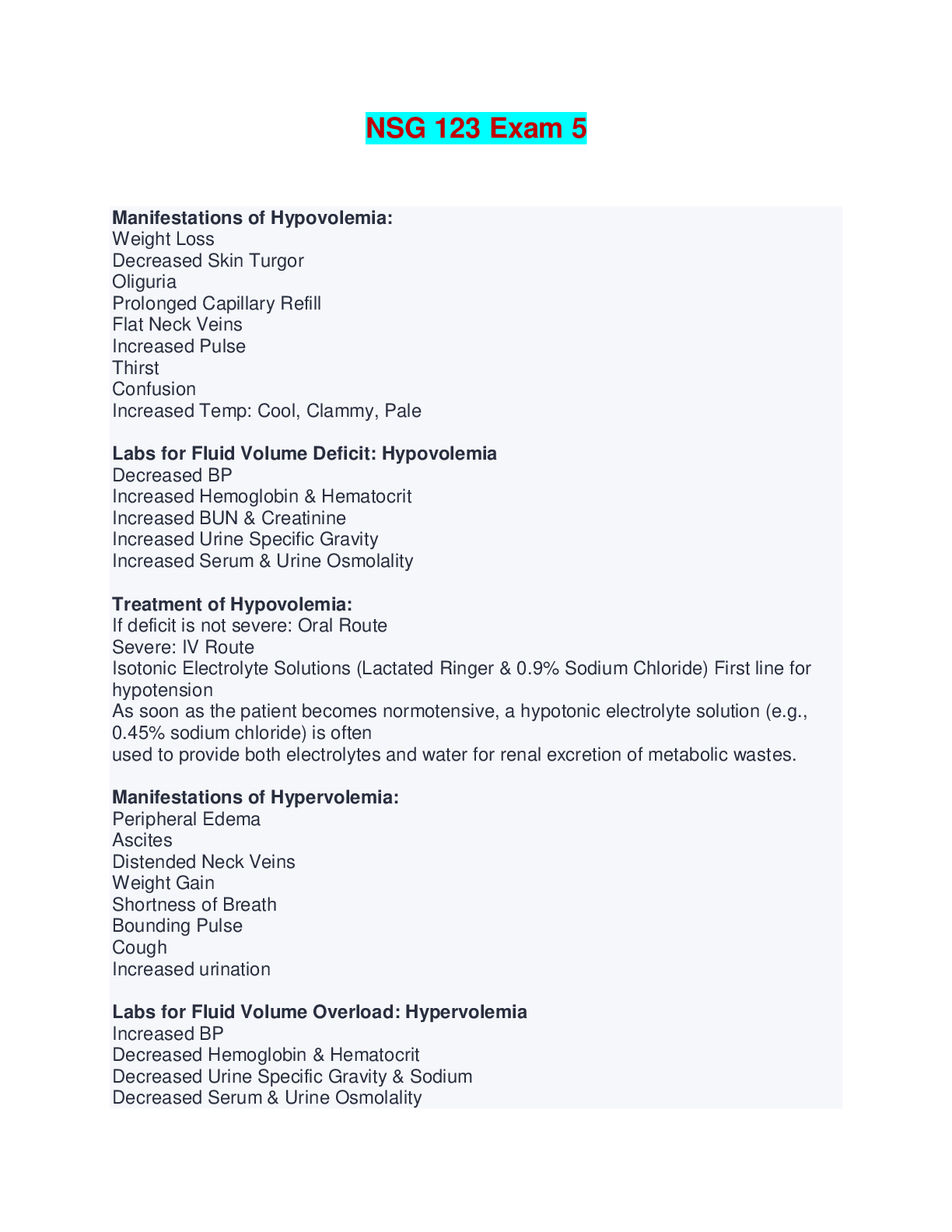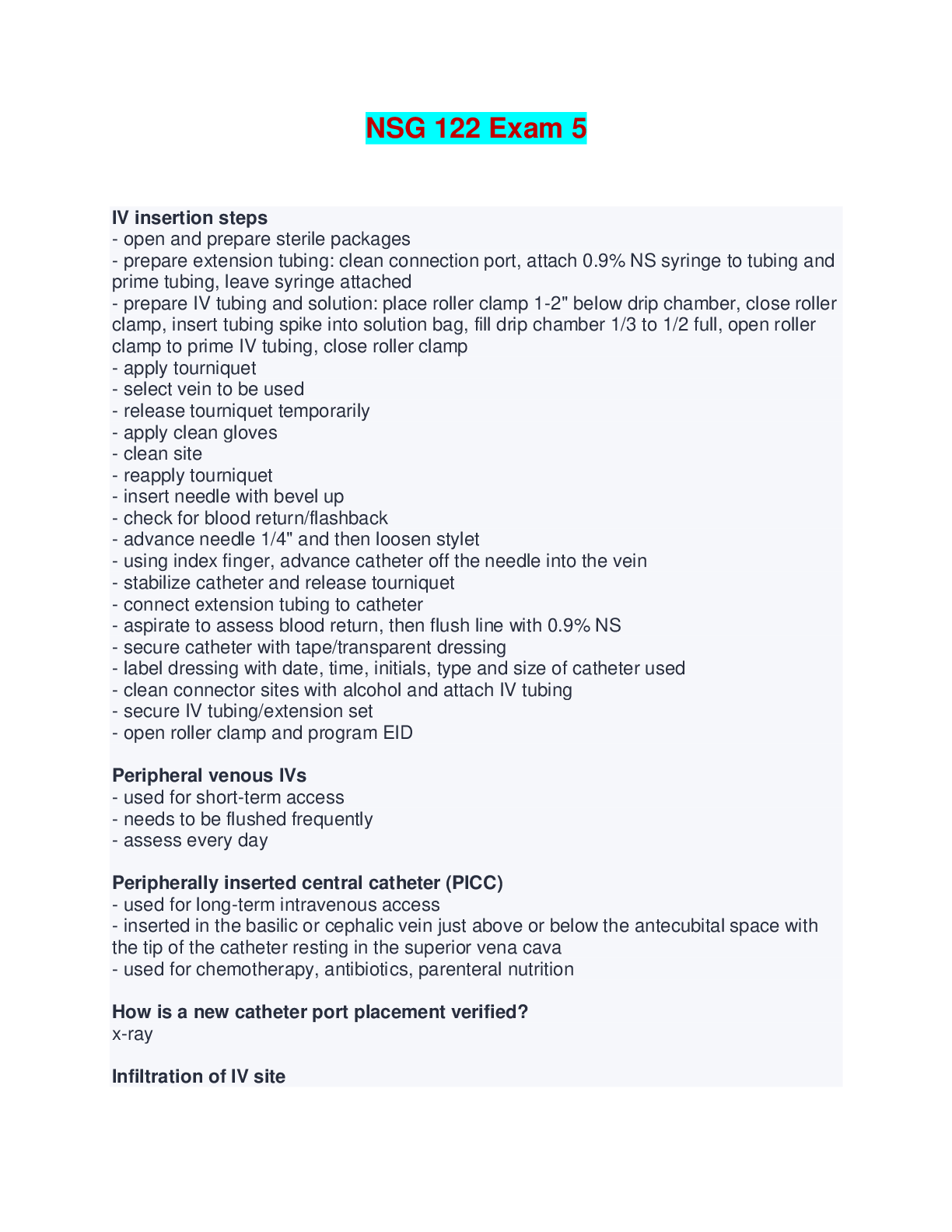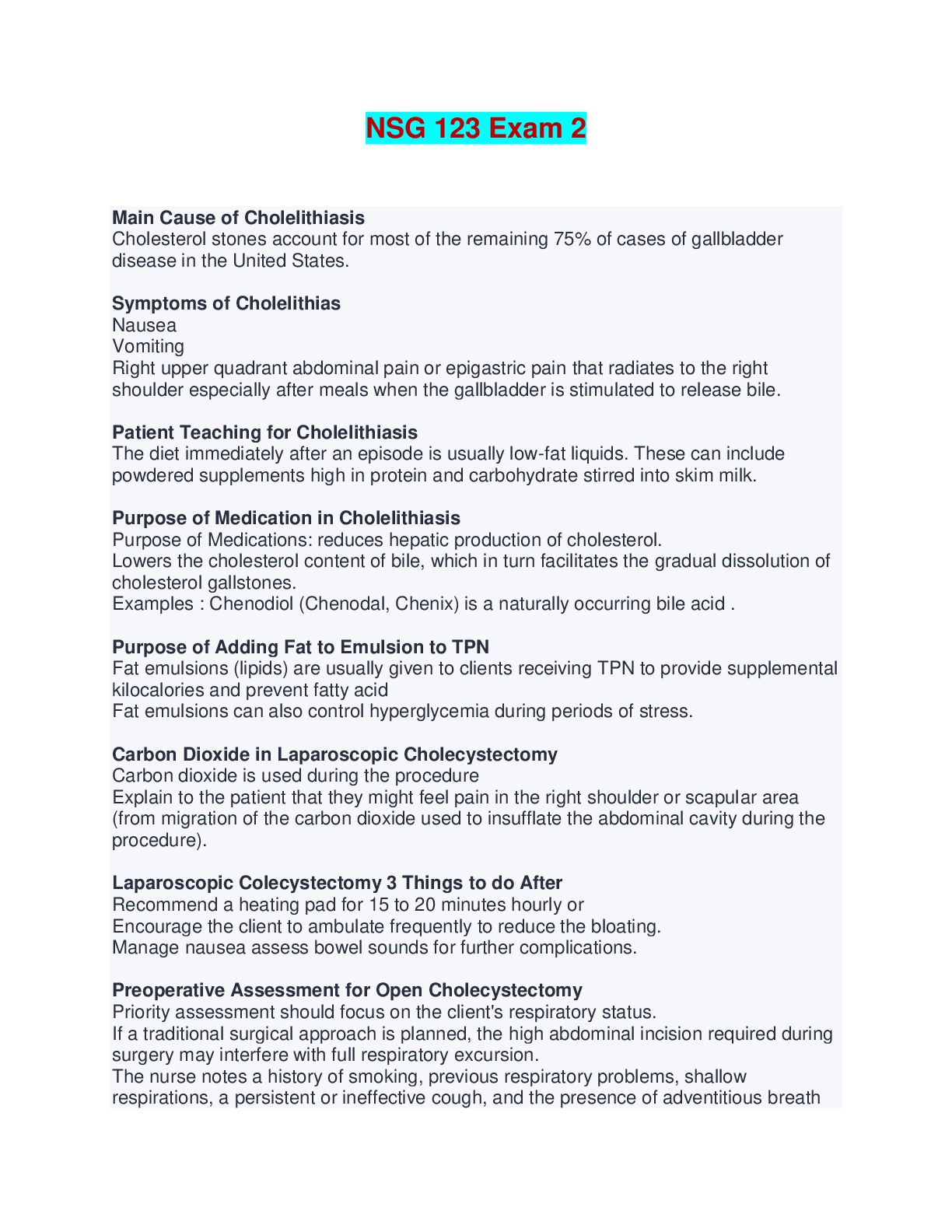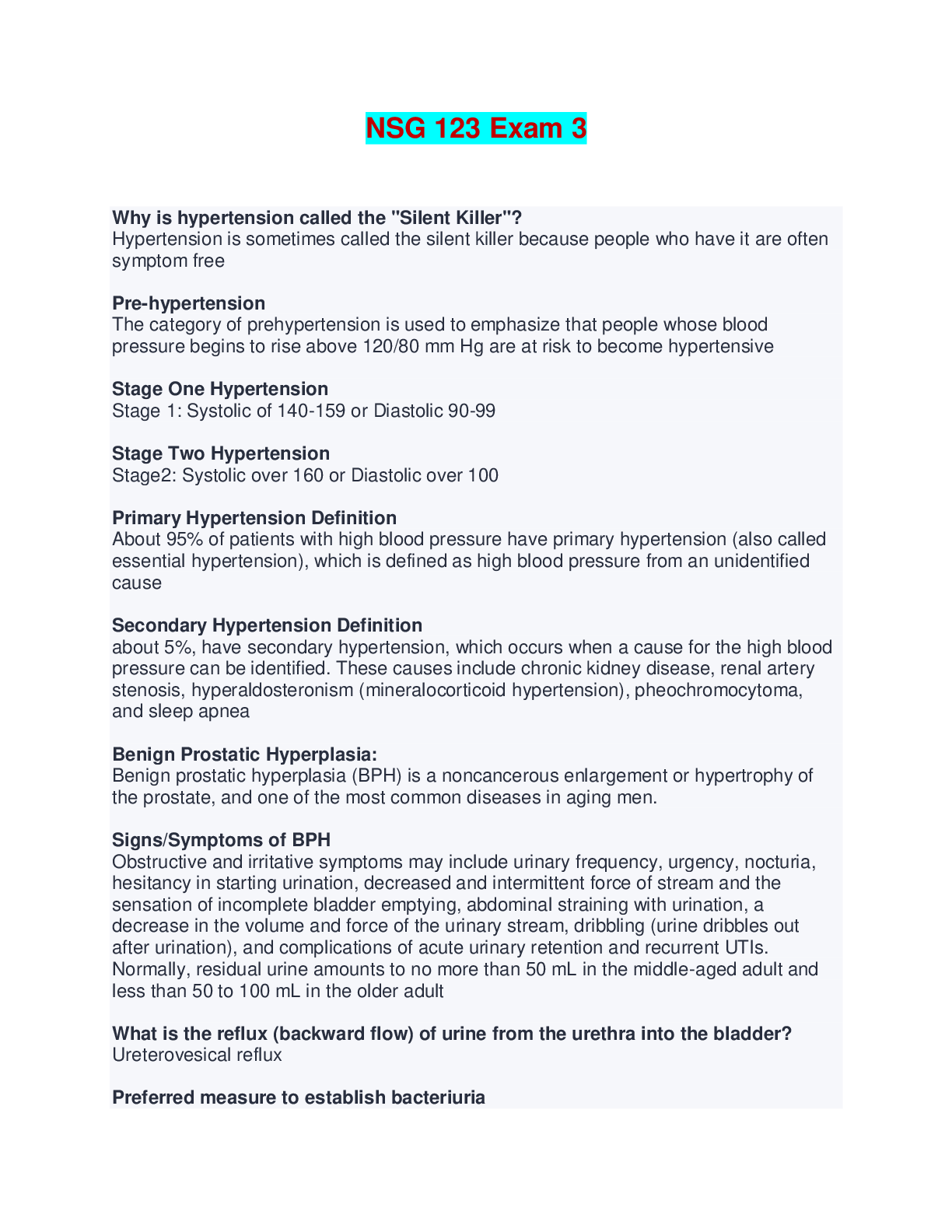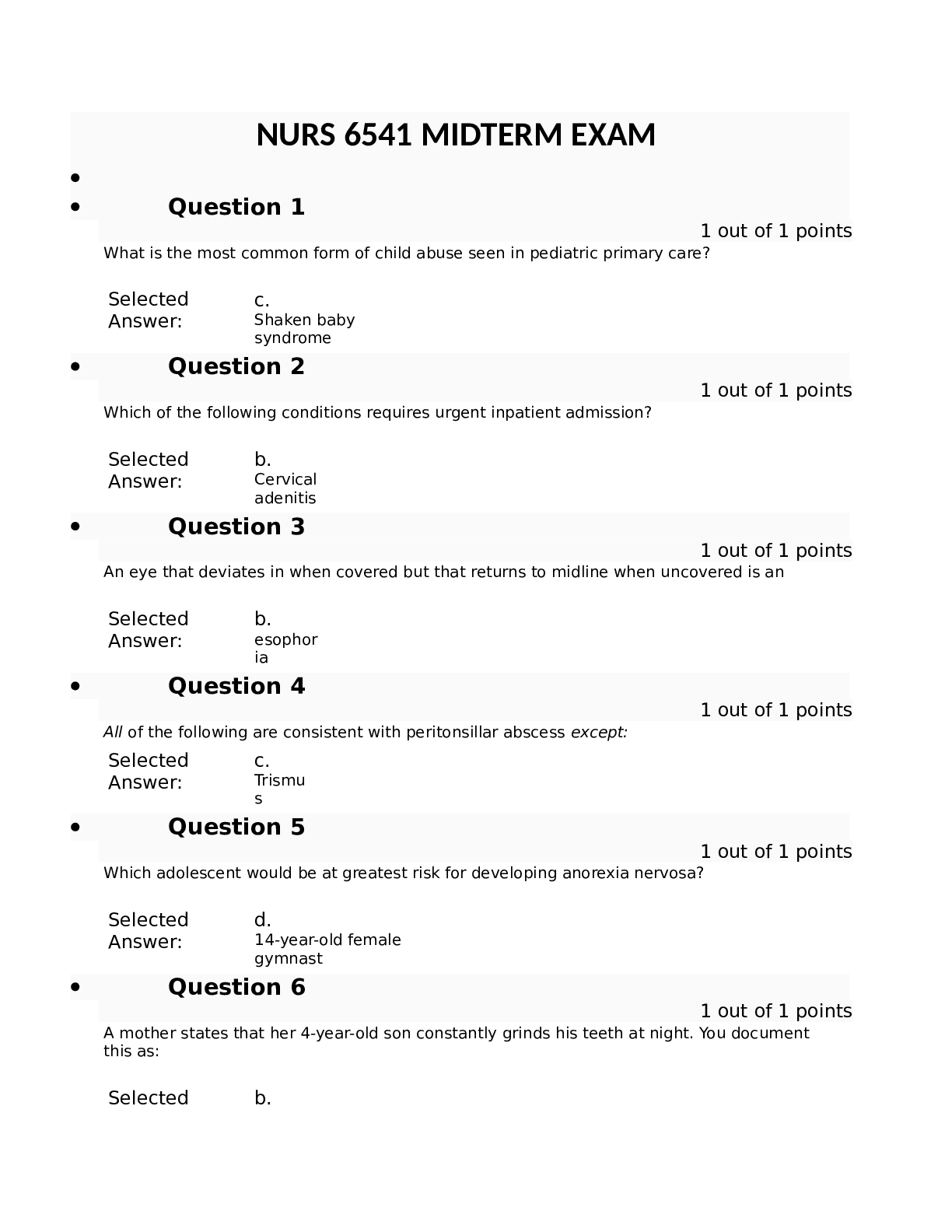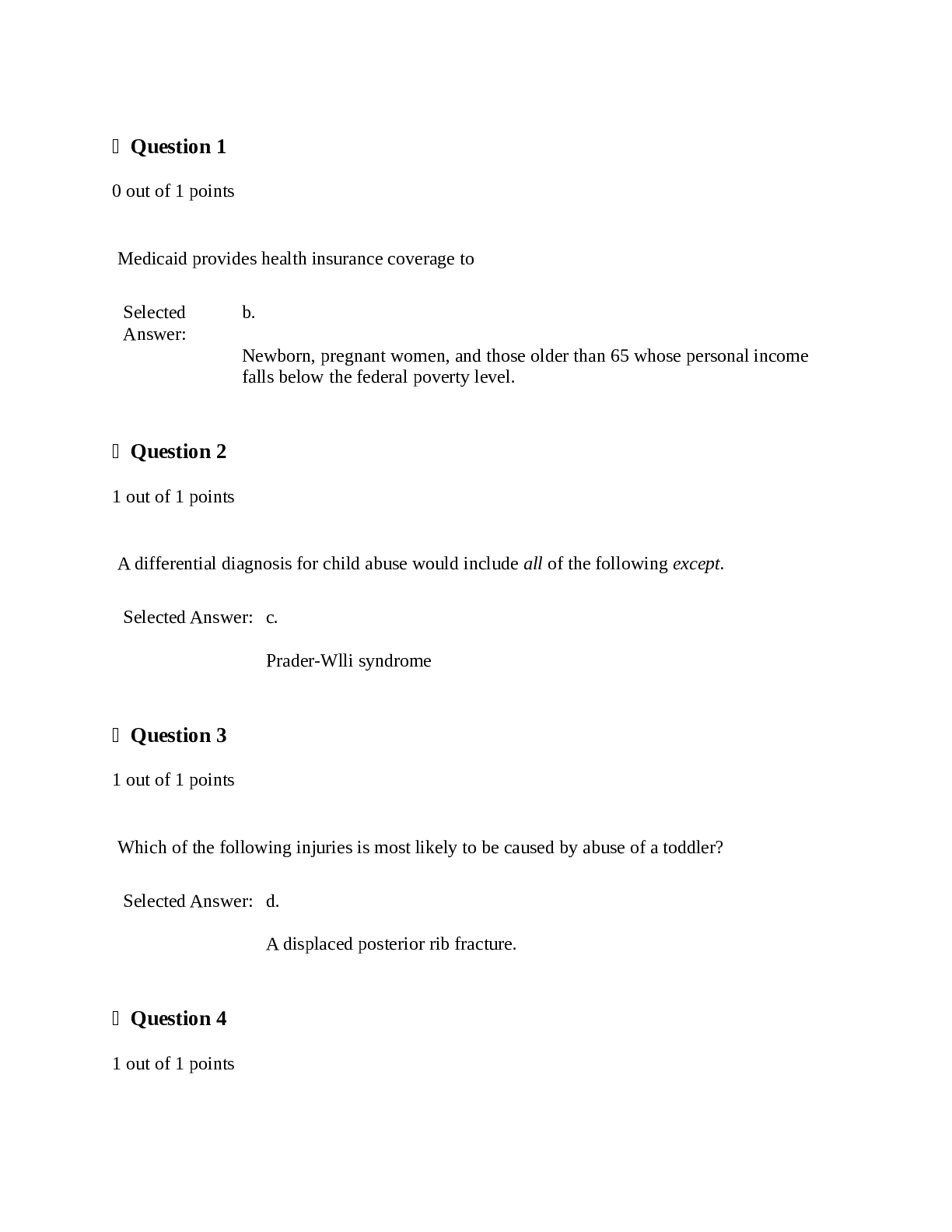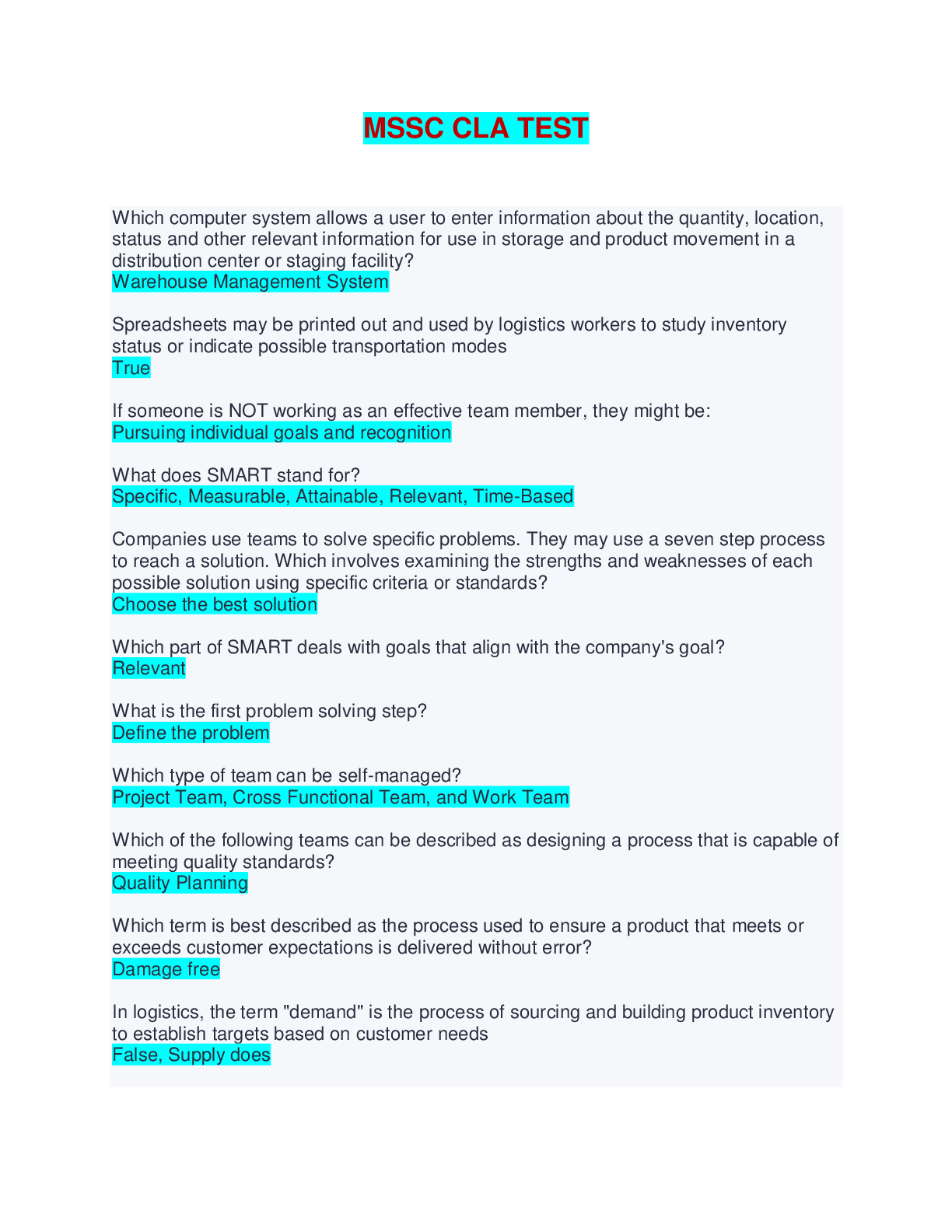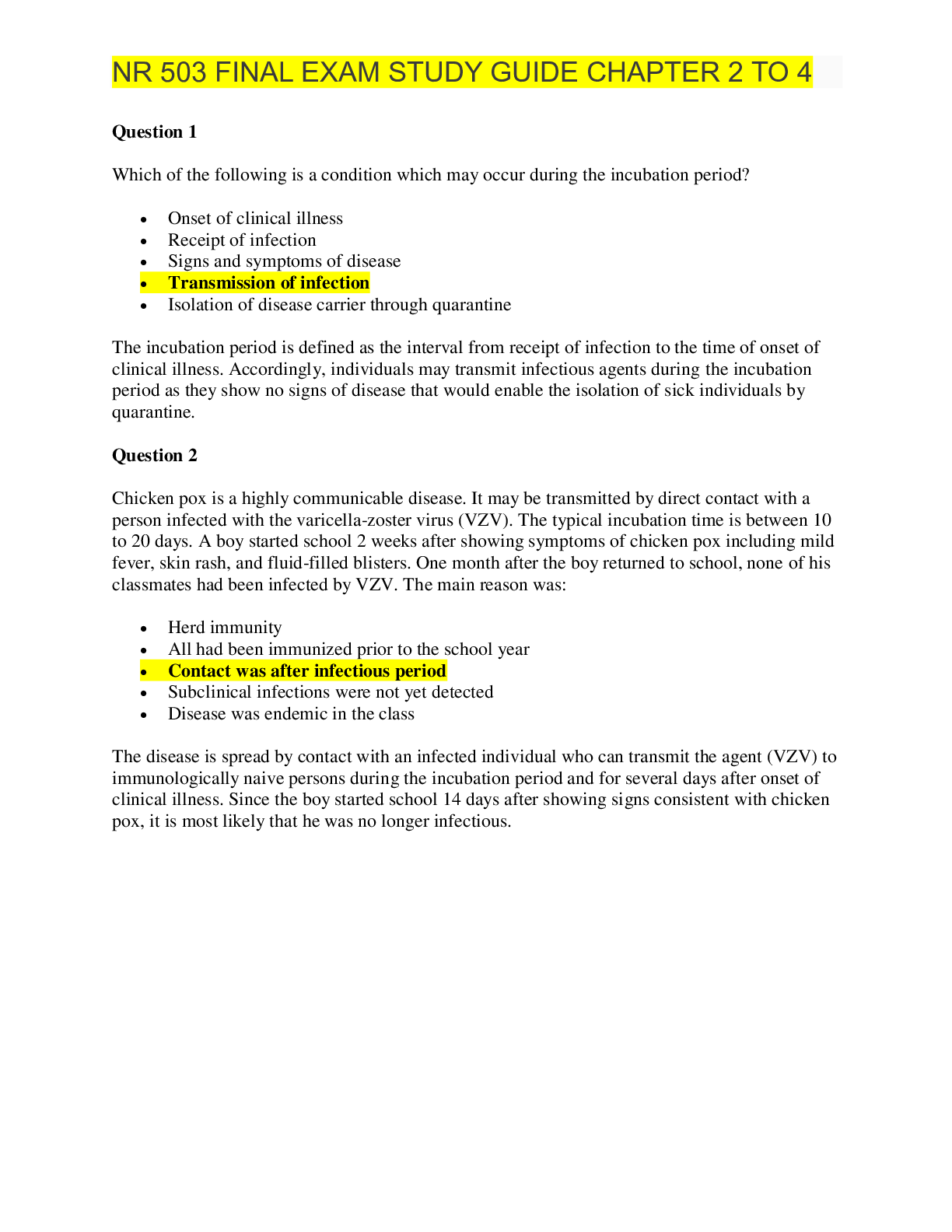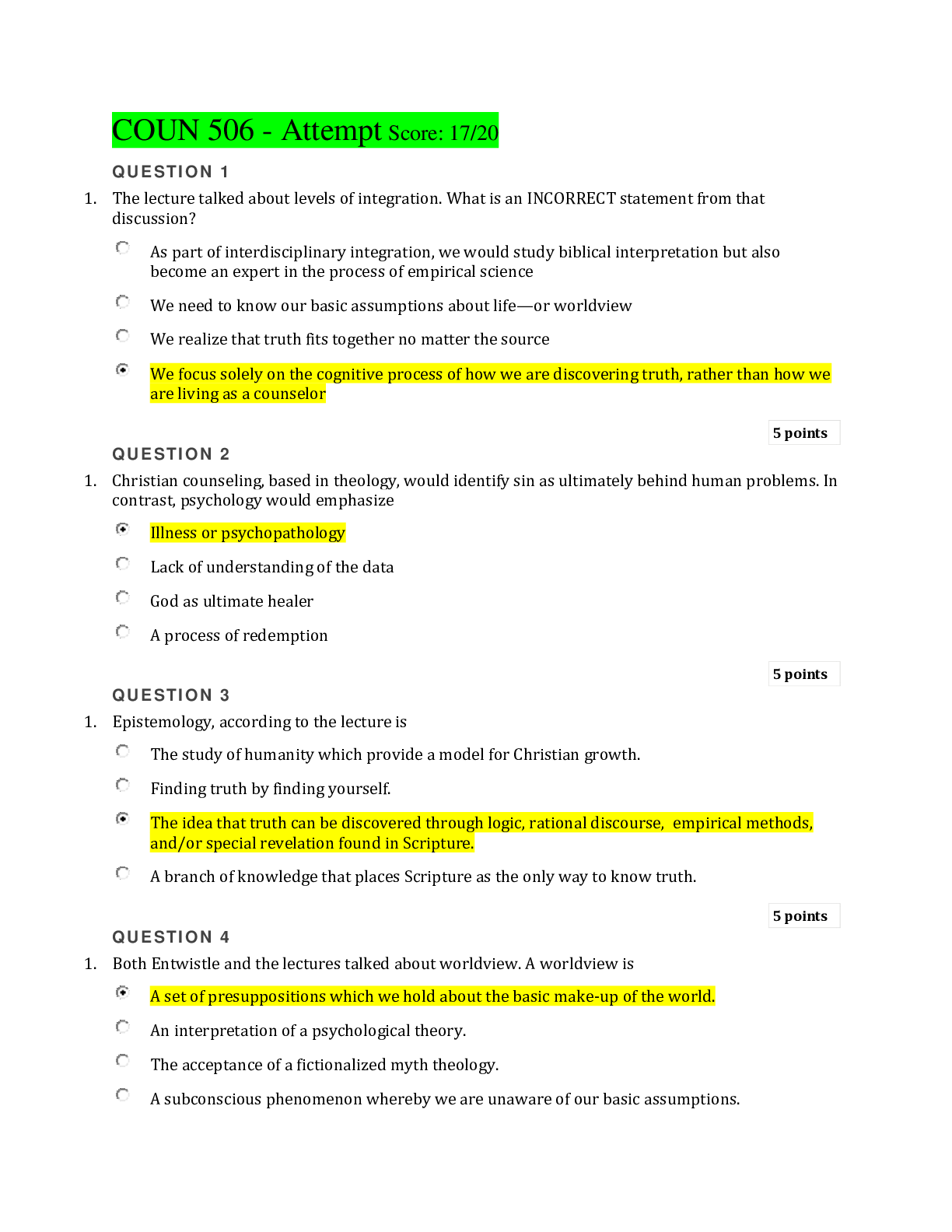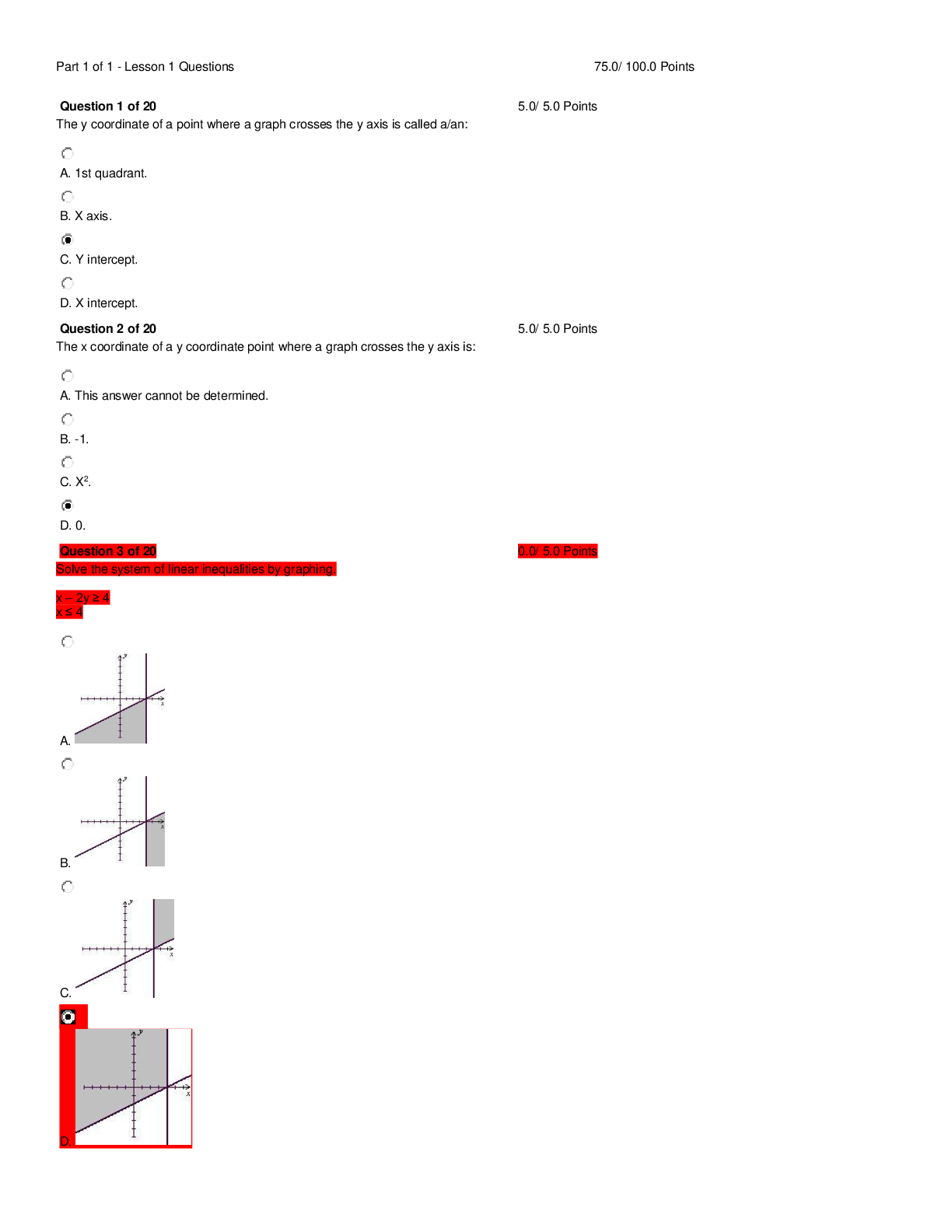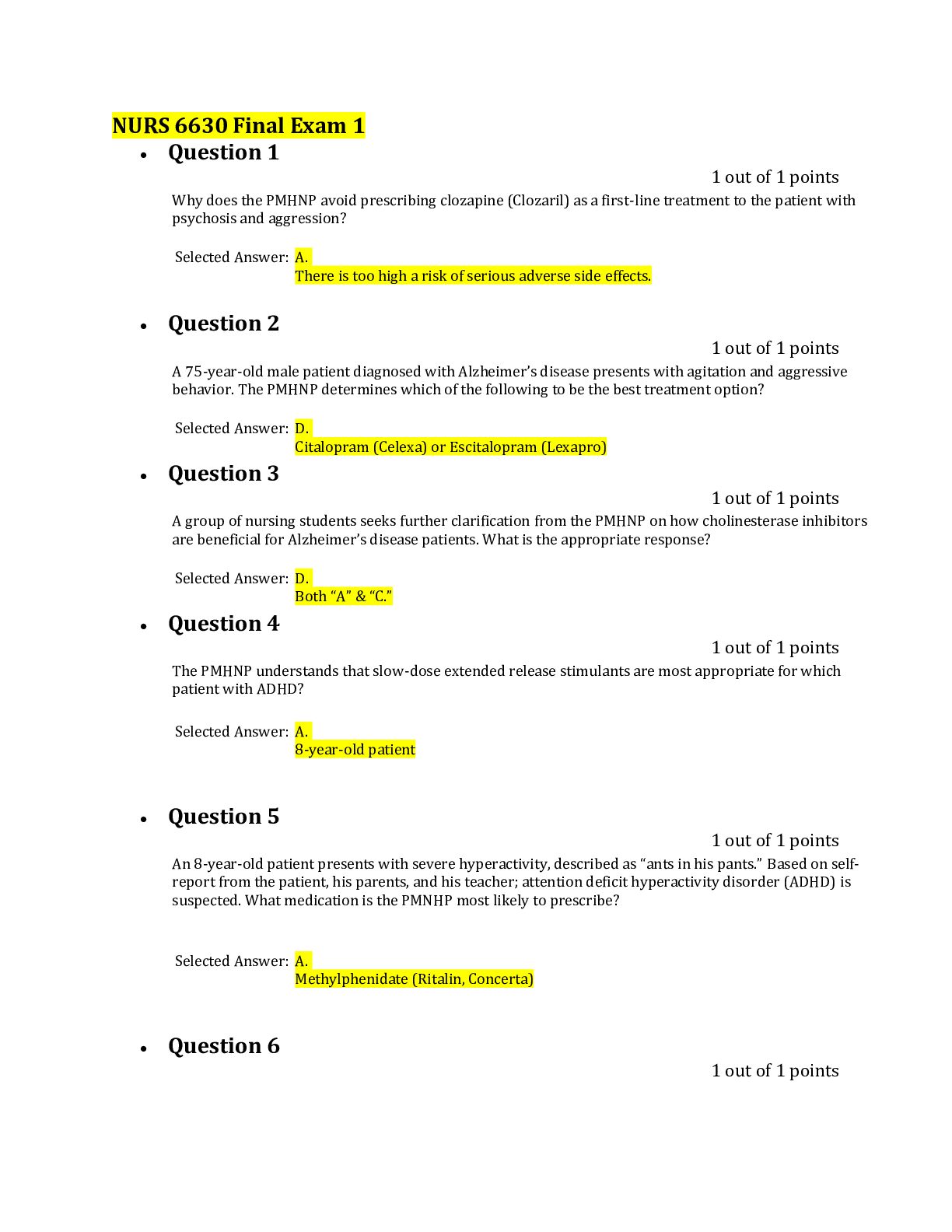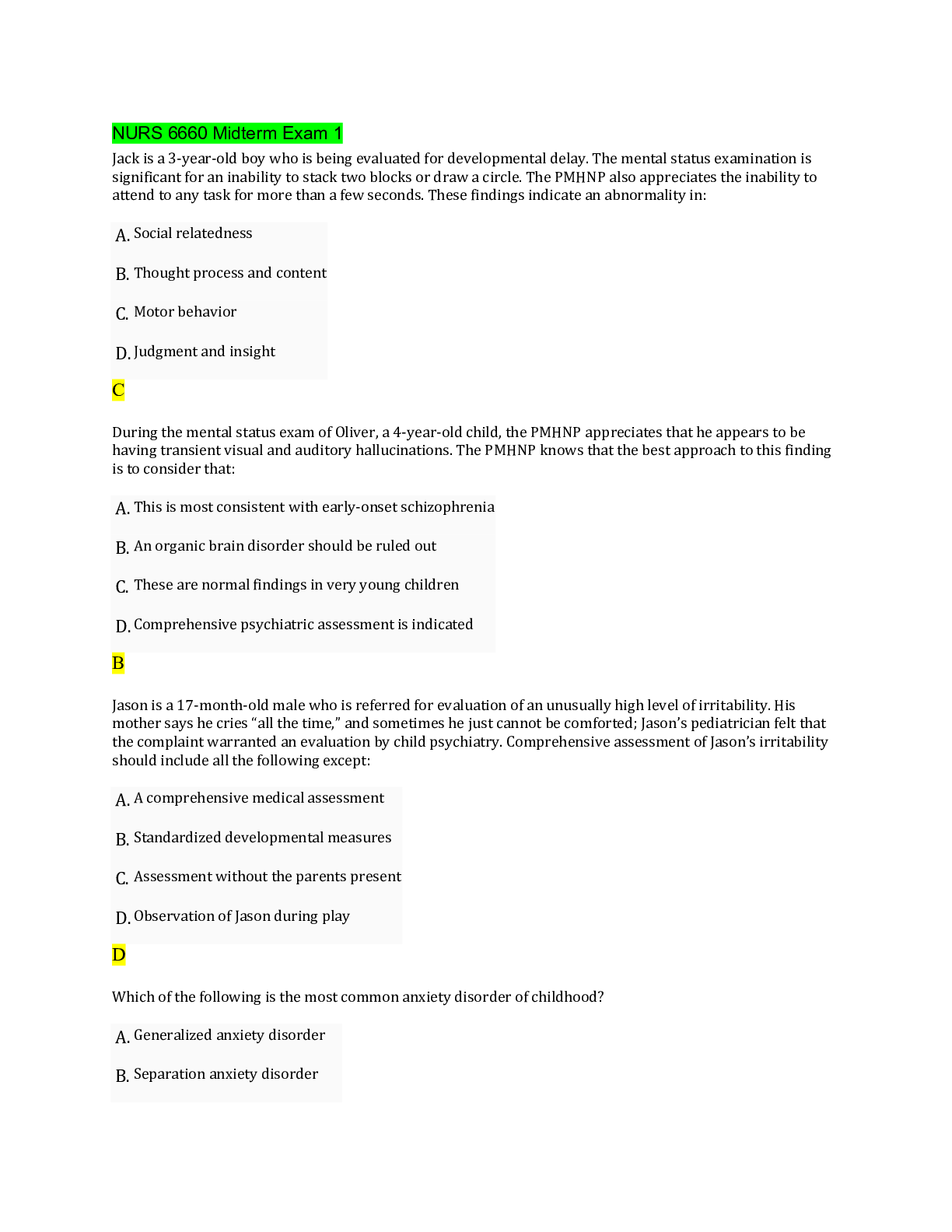NSG 441 Exam 1 | Complete Solutions (Verified)
Document Content and Description Below
NSG 441 Exam 1 | Complete Solutions (Verified) The nurse manager is coaching a new graduate nurse about role performance on the clinical unit. Which types of power are effective when coaching a new... employee to improve role performance? Select all that apply. -expert -position -reward -coercive -information -connection Rationale: Effective coaching makes use of expert power, position power, and information power. Expert power is based on expertise and credibility. The new employee needs knowledge and skills of the nurse manager to identify role performance expectations with position power. Information power stems from the nurse manager's possession of critical information needed by the new employee. Coercive power is derived from someone's perceived fear of another person and is not a positive motivating tool in coaching. in this situation, the nurse managers i the power figure; the manager is not using connection with a powerful figure. reward powers i being able to provide rewards for favor and is not illustrated in this scenario. The leadership role of professional nurses in the United States has evolved in the 21st century. Which factor most describes the nurse's leadership role in shaping the healthcare environment? - nurses remaining neither powerful nor political -nurses providing education to patients and families -nurses influencing health care through political action -nurses exercising power to create a strong voice for nursing. Rationale: in the 21st century, nurses must exercise their power to create a strong voice for nursing in shaping an evolving healthcare environment. Nurses providing education to patients influences the patients to charge behavior to promote optimal health. in the 19th century, women were viewed as neither powerful nor political. nurses can influence health care through politics, but this is not the only way to do so. The key for renewal is the release of human energy and talent. Leaders know that which elements are required for renewal to occur? Select all that apply. - focused energy - staff recognition - development of trust - conflict management - personal well-being Rationale: Focused energy and personal well-being are essential for the release of human energy and talent; according to Gardner, the task of renewing. Staff recognition is important and helps build confidence in the team. Developing trust in one of Gardner's tasks of leading and managing and is important to help keep staff aware of the organizational decisions and initiatives., but it is not involved in renewal. The skill of conflict management is essential for mangers to master to keep the lines of communication open and for the team to grow. Which statement describes complex adaptive leadership theory? - Leaders attend to the needs and motives of followers. - Leaders have a certain set of traits that inspire others. - Leaders motivate others through the hierarchy of human needs. - Leaders respond to patient and organization problems differently. Rationale: In complex, adaptive leadership, leaders respond to patient and organization problems differently. In transformational leadership, leaders attended to the needs and motives of followers. Trait theory states that leaders have a certain set of traits that inspire others. The hierarchy of needs theory states that leaders motivate others through the hierarchy of human needs. Which statement describes trait theory? -Leaders have a certain set of characteristics that inspire others. - Leaders motivate others through the hierarchy of human needs. - Leaders attend to the needs and motives of followers. - Leaders respond to patient and organization problems differently. Rationale: Trait theory states that leaders have a certain set of physical and emotional characteristics that inspire others. The hierarchy of needs theory states that leaders motivate other through the hierarchy of human needs. In transformational leadership, leaders attend to the needs and motives of followers. In complex adaptive leadership, leaders respond to patient and organization problems differently. Which statements below reflect traits emotionally intelligent nurses display as credible leaders? Select all that apply. -Awareness of the individual, family, or community - Enhanced organizational skills -Investment in relationships - Adoption of group behaviors -Commitment to self-growth Rationale: Emotionally intelligent nurses are credible as leaders because they possess awareness of the individual, family, or community being cared for; have enhanced organizational skills resulting from investment in relationships; and a commitment to self-growth. Adoption of group behaviors would not yield a credible leader if the behaviors were negative or ineffective. Which statement is accurate regarding the difference between leading and managing? - A leader functions without the use of a predesigned plan, whereas a manager focuses on situations where the outcomes are known or preestablished. -A leader relies on control in situations with known outcomes, whereas a manager inspires trust through honest communication. - A leader imitates established protocols, whereas a manager originates new ideas to address emerging situations. - A leader administers policies adhering to processes for efficiency, whereas a manager innovates in the midst of complex, uncharted circumstances. Rationale: Leading is required when the unknown presents itself, necessitating the use of principles to improvise solutions and help others cope, thrive, and function in the situation. Managing is the ability to plan, direct, control, and evaluate others in situations where the outcomes are known or preestablished. A manger relies on control, whereas a leader inspires trust. The manager imitates, whereas the leader originates. The manager administers; the leader innovates. The nurse manager of a large medical-surgical unit wants to ensure brief and concise daily communication exchange that engages team members to identify any important needs or safety issues. Which strategy should the nurse manager use to communicate in this way? - Email -Huddle - Newsletter -Staff meeting Rationale: the nurse manager of a large unit would implement the huddle as a daily brief and concise communication exchange that engages team members to identify any important needs or safety issues. Emails can become lost within the team's electronic mailboxes, not be identified as urgent or important, or may go unread. Newsletters, in either paper or electronic form, will not be identified by the team as urgent or important and there is no way to ensure that they are read. Daily staff meetings would not be feasible. The new graduate nursing orientation program supports professional development throughout the nurse's career. Which theorist developed this approach? - Robert Kelley - Patricia Benner - Dorothea Orem - Ida Jean Orlando Rationale: Patricia Benner developed a novice-to-expert theory that addresses how nurses progress throughout their careers. Robert E. Kelley decided that the world of business needed to pay attention to followers; he stated leaders do not live and thrive without followers. Dorothea Orem places the nurse in an active, participatory role within the career and specifically holds the nurse accountable for the care needs identified as lacking. Ida Jean Orlando requires nurses to incorporate their ideas and feelings and to investigate any assumptions they have about patients. The most effective leaders help followers thrive within the healthcare organization by demonstrating which behavior? -Fostering professional growth - Guiding towards a common goal - Providing clear and concise direction -Setting the tone within the organization Rationale: Effective followers need leaders who foster professional growth. Effective followers then influence the leader by providing intelligent and experience-driven suggestions for solutions. Guiding toward a common goal, providing clear and concise direction, and setting the tone within the organization are traditional leader behaviors but are not specific to helping effective followers thrive. Which describes a NA-TECH (natural technological) type of disaster? -A flood covering crops and recreational areas of a geographic area. -A terrorism attack causing major interruption of communication technologies -A tornado resulting in flood and destruction of electrical systems for a community. -A nuclear accident at a power plant causing evacuation of people in an urban community. Rationale: A natech disaster is a natural disaster that creates or results in a widespread technological problem. A flood covering crops and recreational areas of a geographic area does not mention a technological problem, and a terrorism attack and a nuclear accident are not natural disasters. A family of five people presented to a hospital after the flooding of their urban home. These family members are classified as... -poverty victims -displaced persons -indirect victims -mass casualties Rationale: Displaced persons are those who have to evacuate their home, school, or business as a result of a disaster. An indirect victim may be a family member or friend of the victim or a first responder. A mass casualty event is one in which 100 or more individuals are involved. Poverty is not considered a disaster classification. Which agency has a mission to support citizens and first responders to ensure that as a nation everyone works together to build, sustain, and improve the capacity to prepare for, protect against, respond to, recover from, and mitigate all? -American Red Cross -National Institute of Health -Federal Emergency Management Agency -Centers of Disease Control and Prevention Rationale: FEMA's mission is to support citizens and first responders to ensure that as a nation everyone works together to build, sustain, and improve the capacity to prepare for, protect against, respond to, recover from, and mitigate all. The other agencies may be peripherally involved in national disasters, but it is not their primary focus. You teach a community disaster preparedness class on how to find shelter during and after a disaster situation. This is an example of what kind of prevention? A-Primary B-Secondary C-Tertiary D-Disaster Rationale: Primary prevention occurs in the nondisaster and predisaster stages. Actions during these stages includes developing local, state, and federal disaster plans; conducting drill tests; training volunteers and health care providers; and providing educational programs. Secondary measures are those taken after the disaster has occurred and tertiary measures are aimed at rehabilitation. Disaster prevention is a broad term covering all types. What element of a community disaster plan investigates the citizen's reliance on telephone systems or cell phones during disasters? A-Authority B-Logistical C-Rescue D-Communication Rationale: Communication is one of the biggest problems during a disaster. The reliance on telephone systems or cell phones should not be the only plan for communication during a disaster. Authority focuses on the people in charge, logistical includes focuses on storage of equipment and location of key responders, and search and rescue focuses on the search and rescue of victims. The nurse at the disaster site is using the SMART triage system. What color triage tag would be provided to an ambulatory individual with a superficial cut on the left elbow and bruise to the right hand? A-Red B-Yellow C-Black D-Green Rationale: Green is for the wounded or individuals with minor injuries who are able to walk and to wait several hours before receiving medical treatment. Red is for those with life-threatening injuries but have a high probability of survival, yellow is for those with systemic but non-life-threatening complications, and black is for the deceased or those with nonsurvivable injuries. Which phase of the community response to disaster includes medical personnel contributing long hours of volunteer work helping unfamiliar people after a disaster? A-Honeymoon phase B-Heroic phase C-Reconstruction phase D-Disillusionment phase Rationale: The heroic phase of a community's reaction to a disaster involves people feeling the need to rush to help people survive the disaster. Medical personnel may volunteer to work long hours without sleep and in dangerous conditions to care for patients. During the honeymoon phase, people who have survived the disaster get together to talk about their experiences. People begin to look to the future during the reconstruction phase and during the disillusionment phase people recognize that many things are different, and much needs to be done to adjust to the current situation. Chemical warfare agents such as pulmonary agents and cyanides are classified as... A-weapons of mass destruction B- computer-based attack weapons C-recovery agents D- prevention medications Rationale: Weapons of mass destruction refer to any weapon that is designed or intended to cause death or serious bodily injury through release, dissemination, or impact of toxic or poisonous chemicals or their precursors. Chemical warfare agents are classified as nerve agents, vesicants, pulmonary agents, and cyanides. Which is the purpose of the staging area in a disaster plan? A-a triage area outside the hospital, supplying first aid and transport to medical facilities. B- A stage for entertainment to cheer up disaster victims C-To provide sheltered area for displaced victims to sleep, eat, and bathe D-to act as command station for disaster responders to report to and get assignments Rationale: The staging area is the onsite command station. Dispatch responders should report to this area and check-in. This allows everyone to be accounted for and to gather assignments. The other options are not appropriate uses for the staging area in a disaster. The community health nurse is working in an emergency shelter with displaced families. Which clients have risk factors for posttraumatic stress disorder (PTSD)? (Select all that apply.) A- an 18-year-old client with a previous gunshot wound. B- A 50-year-old client who saw people die in the disaster C- A 23-year-old client experiencing extreme fear D- A 60-year-old client who had little social support before the event E- A 35-year-old client with a history of schizophrenia Rationale: Risks for PTSD include living through dangerous events or traumas; having a history of mental illness; getting hurt; seeing people hurt or killed; feeling horror, helplessness, or extreme fear; having little or no social support after the event; and dealing with extra stress after the event, such as loss of a loved one, pain and injury, or loss of a job or home. Triple Aim in Healthcare Access, Quality, and Cost of Care Leadership use of individual traits and abilities to interpret an emerging situation and to address the situation in the absence of a script or defined plan. Management the act of any individual who guides others through a series of routines, procedures, or practice guidelines. Followership The optimal use of personal attributes in a team situation, while acquiescing to a peer who is leading or managing, to ensure the best clinical decision making and actions are taken to achieve clinical or organizational outcomes. Emotional intelligence possession of social skills, interpersonal competence, psychological maturity, and emotional awareness devoted to helping people work well together. The Five Domains of Emotional Intelligence -Having self-awareness -Managing emotions -Motivating self -Being empathetic -Handling relationships Attributes of Effective Leaders and Managers -use focused energy and stamina to accomplish a vision -use critical-thinking skills in decision making -trust personal intuition and then back up intuition with facts -accept responsibility willingly and follow up on the consequences of actions taken -identify the needs of others -deal with people skillfully: coach, communicate, counsel -Demonstrate ease in standard/boundary setting -Examine multiple options to accomplish the objective at hand flexibly -Are trustworthy and handle information from various sources with respect for the source -Motivate others assertively toward the object at hand. -Demonstrate competence or are capable of rapid learning in the arena in which change is desired. Leadership Theories Trait, Style, Situational-Contingency, and transformational. Trait Theories Leaders have a certain set of physical and emotional characteristics that are crucial for inspiring others toward a common goal. Some theorist believe that traits are innate and cannot be learned; others believe that leadership traits can be developed in each individual sometimes referred to as "The Great Man Theory" Key researchers: Aristotle and Stogdill Style Theories focus on what leaders do in relational and contextual terms. The achievement of satisfactory performance measures requires supervisors to pursue effective relationships with their subordinates while comprehending the factors in the work environment that influence outcomes Sometimes referred to as "group and exchange" theories. Key researchers: Shartle, Stogdill, and Likert Situational-Contingency theories Three factors are critical: 1. the degree of trust and respect between leaders and followers. 2. the task structure denoting the clarity of goals and the complexity of problems faced 3. the position power in terms of where the leader was able to reward followers and exert influence Consequently, leaders were viewed as able to adapt their style according to the presenting situation. The Vroom-Yetton model was a problem-solving approach to leadership. Path-Goal theory recognized two contingent variables: 1. the personal characteristics of followers and 2. environmental demands. On the basis of these factors, the leader sets forth clear expectations, eliminates obstacles to goal achievements, motivates and rewards staff, and increases opportunities for follower satisfaction based on effective job performance. Researchers: Fiedler, Vroom and Yetton, House and Mitchell Transformational Theories refers to a process whereby the leader attends to the needs and motives of followers so that the interaction raises each to high levels of motivation and morality. The leader is a role model who inspires followers through displayed optimism, provides intellectual stimulation, and encourages follower creativity. Bass, Bennis and Nanus, Tichy and Devanna Motivational Theories Hierarchy of needs Two-factor theory Expectancy theory OB modification Hierarchy of Needs People are motivated by a ____, beginning with physiologic needs and then progressing to safety, social, esteem, and self-acutalizing needs. In this theory, when the need for food, water, air, and other life-sustaining elements is met, the human spirits reaches out to achieve affiliation with others, which promotes the development of self-esteem, competence, achievement, and creativity. Lower-level needs will always drive behavior before higher-level needs will be addressed -Maslow Two-factor theory hygiene factors, such as working conditions, salary, status and security, motivate workers by meeting safety and security needs and avoiding job dissatisfaction. Motivator factors, such as achievement, recognition, and the satisfaction of the work itself, promote job enrichment by creating job satisfaction. -Herzberg Expectancy Theory individuals' perceived needs influence their behavior. In the work setting, this motivated behavior is increased if a person perceives a positive relationship between effort and performance. Motivated behavior is further increased if a positive relationship exists between good performance and outcomes or rewards, particularly when these are valued. -Vroom OB modification an operant approach to organizational behavior. Follows a three-step ABC model: A= antecedent analysis of clear expectations and baseline data collection B= behavioral analysis and determination C= consequence analysis, including reinforcement strategies -Luthans Complexity Theory promotes the idea that the world is full of systems that interact and adapt through relationships. Nurses must be flexible and dynamic to be in tune with the everchanging systems of people, health care, public policy and human relationships Complexity Science Users Develop networks Encourage nonhierarchical interaction among workers Become a leadership "Tag" Focus on emergence Think systematically Gardner's Tasks of Leadership Envisioning goals Affirming values Motivating Managing Achieving workable unity Developing trust Explaining Serving as a symbol Representing the group Renewing Bleich's Tasks of Management 1. Identify systems and processes that require responsibility and accountability and specify who owns the process. 2. Verify minimum and optimum standards/specifications and identify roles and individuals responsible to adhere to them. 3. Validate the knowledge, skills, and abilities of available staff engaged in the process; [Show More]
Last updated: 6 months ago
Preview 5 out of 22 pages

Loading document previews ...
Buy this document to get the full access instantly
Instant Download Access after purchase
Buy NowInstant download
We Accept:

Also available in bundle (1)
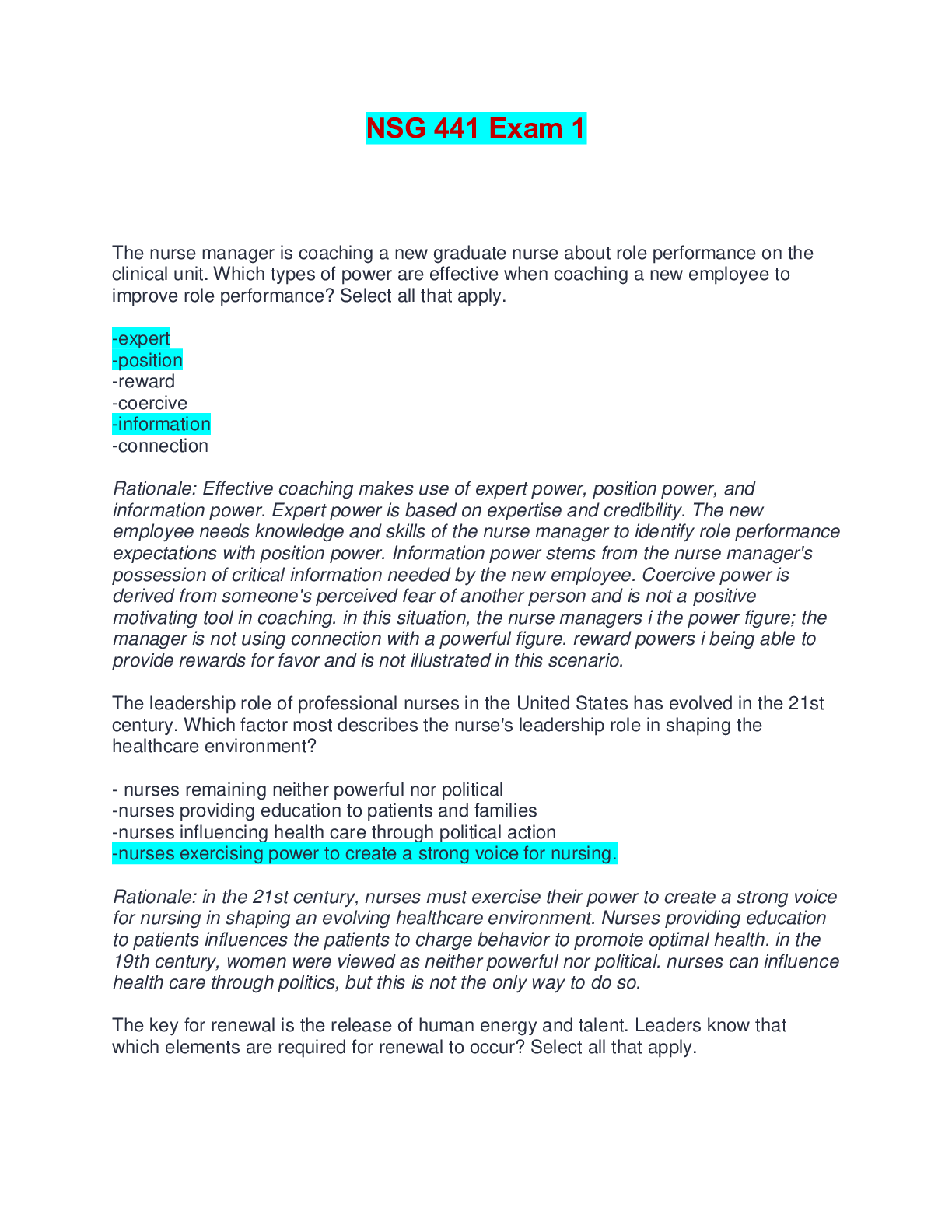
NSG 441 EXAM 1, 3 AND MODULE 1-7 PRACTICE QUESTIONS BUNDLE
NSG 441 EXAM 1, 3 AND MODULE 1-7 PRACTICE QUESTIONS BUNDLE
By Ajay25 6 months ago
$26
3
Reviews( 0 )
$18.00
Can't find what you want? Try our AI powered Search
Document information
Connected school, study & course
About the document
Uploaded On
Dec 09, 2024
Number of pages
22
Written in
Additional information
This document has been written for:
Uploaded
Dec 09, 2024
Downloads
0
Views
9

